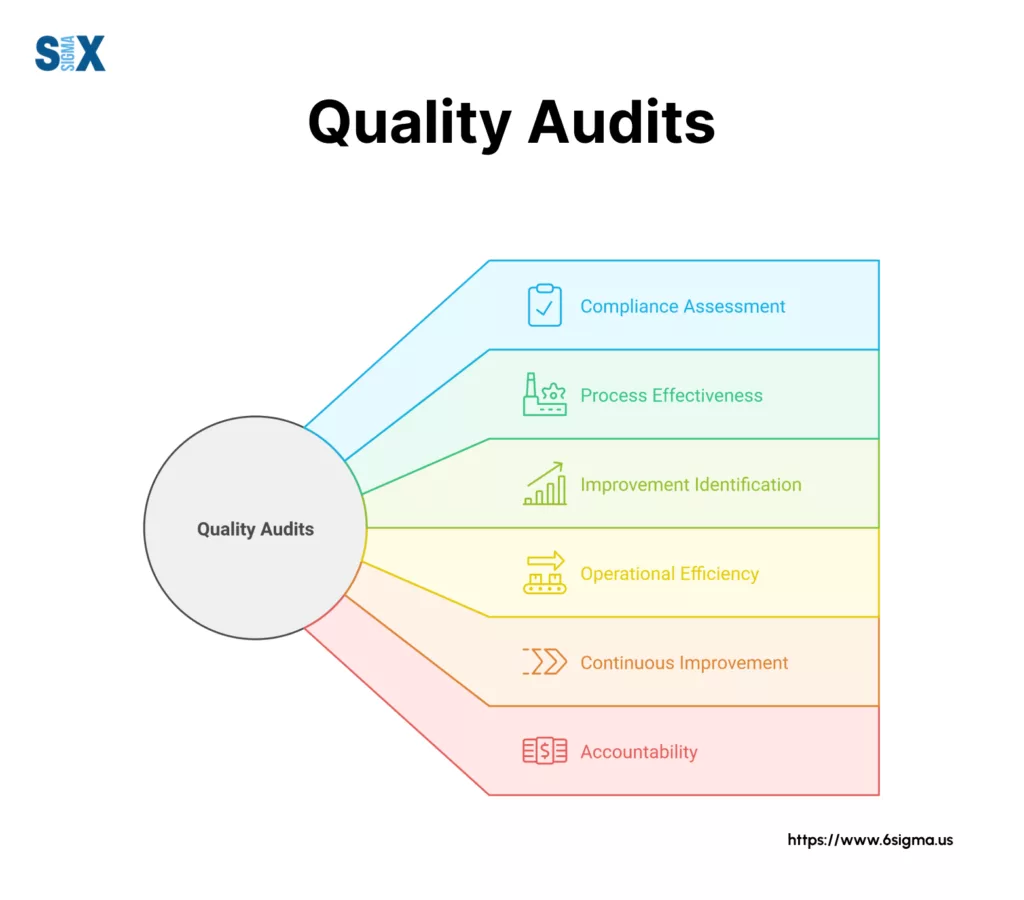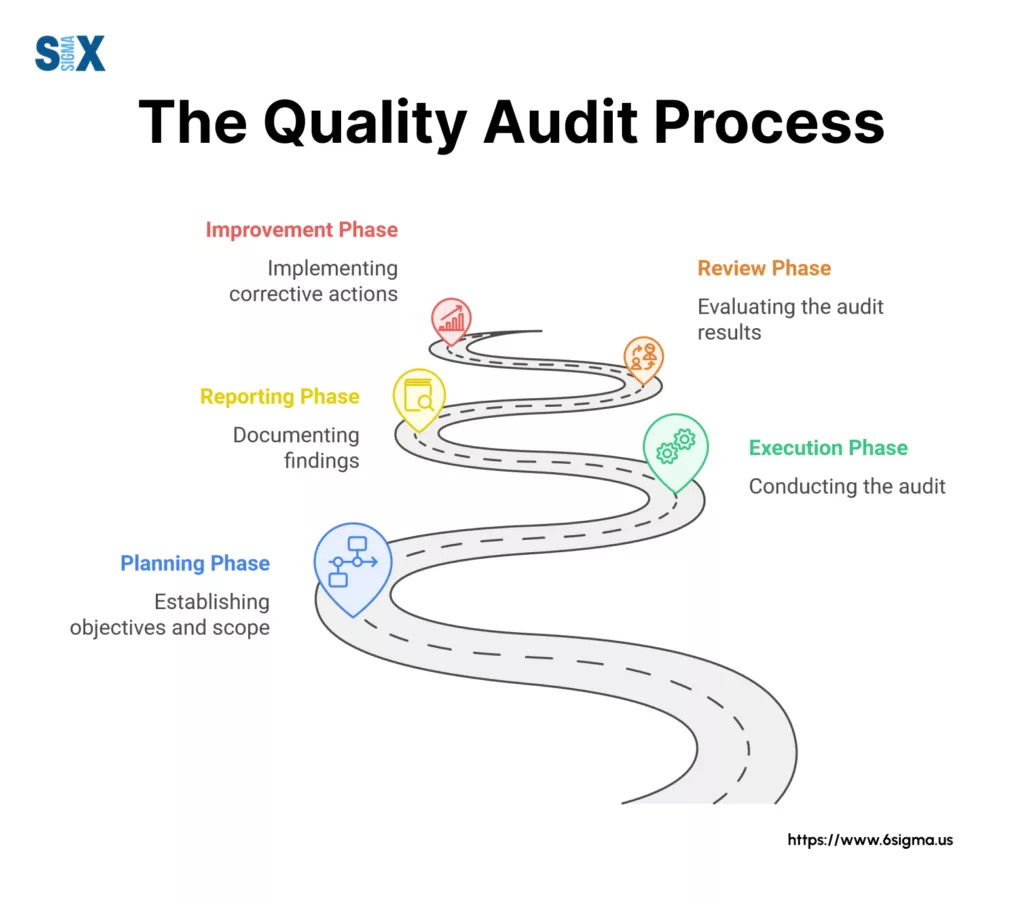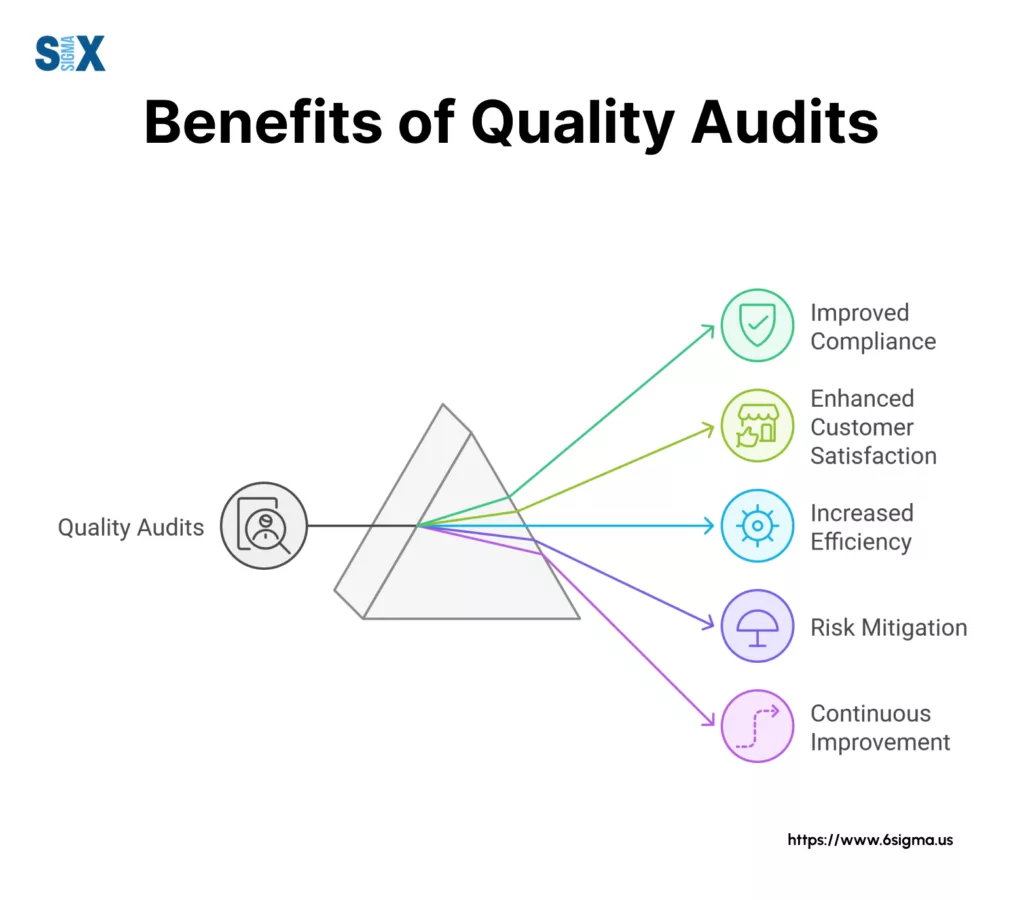The Evolution of Quality Audits: A Modern Approach to Excellence
Quality audit merely meant ticking boxes and filing paperwork. Today, it’s become an integral strategic tool that drives continuous improvement and organizational excellence.
What exactly is a quality audit? It’s a systematic, independent examination of an organization’s quality management system.
But we believe it’s much more than that.
What This Article Will Cover
- The fundamental principles of quality audits and why they matter
- Different types of quality audits and when to use them
- Step-by-step guidance on conducting effective audits
- Quality auditing in different industries
What is Quality Audits?
A quality audit is a systematic, independent examination of an organization’s quality management system.
Most effective quality audits go beyond mere compliance checking – they serve as powerful tools for organizational improvement and risk management.
Think of a quality audit as a health check-up for your organization’s processes and systems.
Just as a doctor examines various aspects of your health, an auditor evaluates different components of your quality management system to ensure everything is functioning optimally.

Purpose and Objectives of a Quality Audit
Successful quality audits typically serve several key objectives:
- Verification of Compliance: Ensuring adherence to standards, regulations, and internal policies
- Risk Management: Identifying potential issues before they become problems
- Process Improvement: Uncovering opportunities for enhanced efficiency
- Documentation Review: Confirming proper record-keeping and system documentation
- Performance Evaluation: Assessing the effectiveness of quality management processes
Types of Quality Audits
There are three main types of quality audits, each serving distinct purposes:
First-Party Audits (Internal)
These are self-assessments conducted by your organization.
- Regular system monitoring
- Preparation for external audits
- Continuous improvement initiatives
- Employee engagement in quality processes
Second-Party Audits (External)
These audits typically involve examining suppliers or contractors. In my experience, they’re crucial for:
- Supplier qualification and monitoring
- Supply chain risk management
- Relationship building with business partners
- Quality assurance in procurement
Third-Party Audits (Independent Certification)
These are conducted by independent certification bodies. They’re essential for:
- Obtaining industry certifications (like ISO 9001)
- Meeting regulatory requirements
- Enhancing market credibility
- Demonstrating commitment to quality
The Role of a Quality Audit in Quality Management Systems
Quality audits play a pivotal role in modern quality management systems.
They serve as:
- A Feedback Mechanism: Providing insights into system effectiveness
- A Learning Tool: Identifying best practices and areas for improvement
- A Communication Channel: Facilitating dialogue about quality across all levels
- A Strategic Asset: Supporting data-driven decision making
A quality audit isn’t just about finding faults – it’s about creating opportunities for improvement and excellence.
The Quality Audit Process: From Planning to Improvement
After managing quality audits for over a decade, we can tell you that the process itself makes or breaks your audit’s success.

Planning Your Quality Audit
The planning phase sets the foundation for your entire audit.
Start by defining your audit’s scope and objectives. You need to know exactly what you’re auditing and why.
Create a timeline that works for both the audit team and the departments being audited. We’ve found that rushing this step often leads to missed opportunities and incomplete findings.
Key planning elements include:
- Selecting qualified auditors
- Gathering relevant documentation
- Setting realistic timelines
- Preparing audit checklists
- Notifying all stakeholders
Conducting The Audit
During the audit phase, your planning comes to life.
Modern quality audits now often include remote elements.
The key is maintaining clear communication channels and documenting everything meticulously.
Your audit should follow a structured approach:
- Opening meeting with stakeholders
- Document review and verification
- Process observation and interviews
- Evidence collection
- Initial findings compilation
Reporting and Follow-Up
Writing audit reports is an art. They must be clear, factual, and actionable. Great audits also fail because their findings weren’t communicated effectively.
Your report should highlight both conformities and non-conformities. Include specific examples and evidence.
When writing reports, always ask yourself, “Would this make sense to someone who wasn’t part of the audit?”
The follow-up phase is crucial. Create a timeline for addressing findings and assign clear responsibilities.
The Continuous Improvement Cycle
Quality audits aren’t one-time events. They’re part of a continuous improvement cycle. Each audit should build on previous findings and help drive organizational growth.
Consider these improvement cycle elements:
- Regular review of past audit findings
- Tracking of improvement metrics
- Updates to audit procedures based on lessons learned
- Integration of new technologies and methods
Tip: Keep detailed records of your audit process improvements. They’re invaluable for future planning and demonstrating the value of your quality audit program to stakeholders.
A successful quality audit isn’t about finding faults – it’s about driving improvement. By following these steps and adapting them to your organization’s needs, you’ll create a robust audit process that delivers real value.
Optimize your quality audit processes and drive organizational excellence with our Green Belt training
Benefits of Quality Audits: Real Results That Matter
Conducting quality audits across different industries, can transform organizations.

Meeting Standards and Regulations
Quality audits help you stay ahead of regulatory requirements.
The regulatory landscape keeps changing, and quality audits serve as your early warning system. They help you spot gaps in compliance before they become problems.
Finding Ways to Improve with a Quality Audit
The best part of this job is helping companies discover improvement opportunities they didn’t know existed.
Modern quality audits use data analytics to uncover patterns. Once identified, they fixed it within weeks.
Boosting Customer Satisfaction
Happy customers stay longer and spend more. Through quality audits, you can spot and fix issues before they affect your customers.
Quality audits also help you understand what your customers really want. By examining processes from the customer’s perspective, you often find simple improvements that make a big difference.
Cutting Costs and Boosting Efficiency with a Quality Audit
Money saved is money earned. Quality audits regularly uncover cost-saving opportunities.
Some common areas where quality audits find savings:
- Reduced waste in production
- Streamlined workflows
- Better resource allocation
- Fewer errors and rework
- Lower compliance costs
Creating a Quality-First Culture
The most valuable benefit is how quality audits change company culture.
When done right, they stop being dreaded inspections and become tools for improvement that everyone embraces.
Tips for building this culture:
- Share audit results openly
- Celebrate improvements
- Involve staff in solutions
- Recognize quality champions
- Make quality everyone’s job
Looking ahead, quality audits will become even more valuable as businesses face new challenges.
Remote work, digital transformation, and sustainability requirements are changing how we think about quality. Smart organizations are already adapting their audit processes to address these shifts.
The return on investment from quality audits goes far beyond avoiding problems. They’re tools for growth, improvement, and building stronger organizations.

Drive organizational excellence through quality with Our Black Belt training in advanced quality management techniques and leadership strategies.
Quality Audit Best Practices: Field-Tested Strategies That Work
Here’s what makes the biggest difference in audit success.
Creating Effective Quality Audit Checklists
Your checklist can make or break your quality audit.
Start with your basic requirements, then add specific items based on:
- Past audit findings
- Recent process changes
- Industry regulations
- Customer feedback
- Risk assessments
Keep your checklist dynamic. Update it based on new findings and changing requirements. One of my clients reviews and updates their checklist quarterly, which has helped them catch 30% more issues.
Building a Strong Audit Team
The best audit checklist won’t help if your auditors aren’t properly trained. Spend considerable time training auditors, focusing on both technical skills and soft skills like communication and observation.
Key areas for auditor training:
- Industry-specific regulations
- Interviewing techniques
- Documentation methods
- Root cause analysis
- Report writing
Many quality audits fail because auditors weren’t qualified for specific industries. Make sure your team understands the technical aspects of what they’re auditing.
Mastering Quality Audit Communication
Clear communication makes tough conversations easier.
Tips for better audit communication:
- Set clear expectations upfront
- Use simple, direct language
- Focus on facts, not fault
- Listen actively to explanations
- Document conversations accurately
Using Technology Effectively
Technology has changed how we conduct quality audits. Which has recently switched from paper checklists to a digital audit platform, cutting report writing time by 50%.
Modern audit tools found helpful:
- Mobile audit apps
- Cloud-based documentation
- Real-time data collection
- Automated reporting tools
- Video conferencing for remote audits
Remember, technology should make your job easier, not more complicated. Choose tools that fit your team’s skills and needs.
Overcoming Common Audit Challenges
Every quality audit faces obstacles. Here’s how you can handle the most common ones:
Resistance from auditees: Build relationships before the audit. Always schedule pre-audit meetings to explain the process and address concerns.
Time constraints: Prioritize high-risk areas. During a recent manufacturing audit, we focused on critical processes first, ensuring we captured the most important information.
Documentation gaps: Create templates and systems for consistent documentation. This saved one of my clients hours of searching during their ISO certification audit.
Remote audit limitations: Use video calls effectively. Having auditees narrate their processes while showing them on camera works better than static pictures.
Looking ahead, quality audits will keep evolving. AI and machine learning are already helping spot trends in audit data.
Moving Forward With Quality Audits
Organizations transform their operations through well-executed audit programs. These are some final thoughts on making quality audits work for your organization.
Key Takeaways From the Trenches
Quality audits aren’t just checkbox exercises – they’re powerful tools for improvement. Each serves a specific purpose in your quality journey.
Internal audits help you stay on track, supplier audits maintain your supply chain quality, and third-party audits validate your efforts.
The audit process covered earlier – from planning through execution to follow-up – works.
Why Quality Audits Matter More Than Ever
Business moves faster today than ever before. Quality audits help you keep pace while maintaining standards.
They:
- Catch problems before they grow
- Drive continuous improvement
- Build customer confidence
- Reduce operational costs
- Support regulatory compliance
Taking Action: Your Next Steps
Ready to improve your quality audit program? Here’s what we recommend:
- Review your current audit process against the best practices we’ve discussed
- Identify gaps in your approach
- Create an action plan to address these gaps
- Train your team on modern audit techniques
- Start small, but start now
If you’re new to quality audits, begin with internal audits of one department or process. Build confidence and competence before expanding.
For experienced quality professionals, look at emerging trends like:
- Digital audit tools
- Remote auditing capabilities
- AI-powered data analysis
- Sustainability metrics
They started with one simple change: making their audit findings visible to everyone. Small steps often lead to big improvements.
Quality audits will keep evolving, but their fundamental value remains constant.
They help you deliver better products, serve customers more effectively, and build stronger organizations.
Don’t wait for problems to start your quality audit journey.
Remember, every successful quality audit program started with a single step. Take yours today.
SixSigma.us offers both Live Virtual classes as well as Online Self-Paced training. Most option includes access to the same great Master Black Belt instructors that teach our World Class in-person sessions. Sign-up today!
Virtual Classroom Training Programs Self-Paced Online Training Programs








